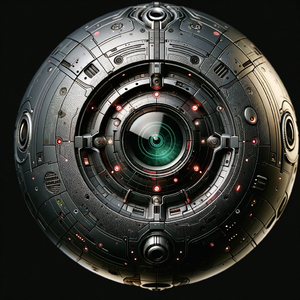

The Deamhain Aeir represents a significant advancement in autonomous drone technology with applications in space exploration and defense. Though their official name is the Deamhain Aeir, it is often referred to as some variation of Blasty Bois or Ghosty Bois colloquially when used. The integrated circular ports serve a dual purpose, functioning effectively as both propulsion thrusters and environmental sensors, thereby providing the device with exceptional maneuverability and situational awareness. The central aperture, emitting a distinctive greenish hue, is a sophisticated sensor array that enhances the drone's targeting and scanning capabilities. Red-lit indicators embedded across the surface offer visual feedback on the device's status, contributing to ease of maintenance and operational monitoring. The design's modular design not only facilitates robust performance in diverse conditions but also allows for rapid repair and adaptation to various mission parameters. Overall, the device's capabilities have been proven in field deployments, showcasing its ability to operate autonomously with high efficiency and reliability, both in the vacuum of space and in planetary atmospheres. Its contribution to strategic operations has been deemed highly valuable, particularly in scenarios requiring stealth, precision, and adaptability.
| Size | 87 mm Spheroid Slightly smaller than an outdoor Polo ball |
| Weight | 1.418 kg |
| Max Speed | 271 kph |
| Standard Speed | 12 kph |
| Power Source | Fusion Power Cells / Spatial Variance Reactor |
| Propulsion | Antigravity with Thrusters |
| Mobility Range | Approximately 1800 km |
| Communication | Approximately 2 AU |
| CPU | Encapsulated Computer Core |
Capabilities
- Autonomous Navigation and Maneuverability
- Leveraging antigravity field generators and ion thrusters, the drones can navigate complex environments independently, executing precise maneuvers with minimal human oversight. This allows for seamless operation in the vast expanse of space, within spacecraft, or on planetary surfaces.
- Stealth Operations
- Equipped with adaptive holographic camouflage, the "Deamhain Aeir" can operate undetected by enemy sensors, making them ideal for stealth missions, ambushes, and reconnaissance without alerting adversaries.
- Swarm Intelligence
- The drones are designed to operate both independently and as part of a coordinated swarm, enabling complex collective strategies. This swarm intelligence facilitates overwhelming assaults, distributed reconnaissance, and redundancy in mission-critical operations, enhancing the overall effectiveness of the fleet's defensive and offensive capabilities.
- Robust Communication Networks
- Utilizing encrypted subspace communication channels across a wide frequency spectrum, the "Deamhain Aeir" maintain constant communication with the central command and each other, allowing for real-time strategy adjustments and high resilience against electronic warfare attempts to disrupt their operations.
- Environmental Adaptability
- With the Environmental Adaptation System, the drones can perform in a variety of conditions, from the vacuum of space to atmospherically dense planets, ensuring operational efficiency regardless of external factors.
- Self-Preservation Mechanisms
- The drones are equipped with systems designed for self-repair and evasion, ensuring sustained functionality during extended missions. In case of severe damage or failure, they are programmed to withdraw or self-destruct to prevent capture and reverse-engineering by adversaries.
- Target Acquisition and Tracking
- Advanced sensor suites enable the "Deamhain Aeir" to detect, identify, and track targets with high precision, facilitating accurate engagement and threat neutralization even in cluttered or contested environments.
- Power Efficiency and Sustainability
- With fusion power cells as the primary power source and the Spatial Variance Reactor (SVR) as a backup, the drones can operate for extended durations without the need for frequent recharging, ensuring they remain operational even during prolonged engagements.
- Configurable Mission Parameters
- The Encapsulated Computer Core (ECC) allows for the programming and reprogramming of mission-specific parameters, enabling the drones to adapt to evolving tactical situations and objectives dynamically. The Particle Emitter Module can also be altered prior to launch, with its default nadion particle configuration, enables the drones to engage a wide range of targets. The ability to reconfigure the emitter for different particle types allows for tactical flexibility, adapting to the specific vulnerabilities of varied threats.
Special Components
- Antigravity Field Generators
- Essential for maneuvering in zero-gravity environments, these generators enable the drones to move with exceptional agility, providing tactical advantages in the spatial dimensions of combat.
- Ion Thrusters
- The primary propulsion system, offering swift and efficient movement with minimal emissions, enhancing both mobility and stealth capabilities.
- Adaptive Holographic Camouflage
- Enables the drones to blend into their surroundings, utilizing dynamic adjustments to remain undetectable to enemy sensors, thus enhancing their stealth and surprise attack capabilities.
- Encapsulated Computer Core (ECC)
- Serving as the processing center, the ECC supports advanced AI algorithms for autonomous operations. Its encapsulated design ensures protection against environmental hazards and electronic warfare, maintaining operational integrity even in adverse conditions.
- Power Sources
- Fusion Power Cells provide a high-density, long-lasting energy supply, crucial for sustaining the drones' operational capabilities over extended periods. The Spatial Variance Reactor (SVR) acts as a secondary power source, offering an alternative energy supply to ensure continuous operation, particularly in energy-intensive or prolonged engagements.
- Particle Emitter Module
- This versatile weapon system is standard configured to emit nadion particles, capitalizing on their destructive potential against a variety of targets. The module's design allows for the emitter to be reconfigured for different types of particles, adapting to specific mission requirements or enemy vulnerabilities, thus providing strategic flexibility in combat scenarios.
- Environmental Adaptation System
- ** Equips the drones to function in diverse environmental conditions, incorporating features for temperature regulation, radiation shielding, and pressure adaptation, ensuring reliable performance across a broad spectrum of operational contexts.
History
In the year 2387, amidst the high-stakes environment of Operation Flintlock, the NVV Duzitzapa faced an unprecedented threat that jeopardized its critical mission: an infestation of the voracious Aloftex Arachnids. It was within this context of urgency and necessity that the genesis of the "Deamhain Aeir" took place, a creation spearheaded by the distinguished engineer Itza.
The journey of the "Deamhain Aeir" began with the adaptation of the SSR (Sputnik Service Robot), a versatile utility device originally designed for maintenance and service tasks aboard spacecraft. Itza, recognizing the potential for a more aggressive application, ingeniously modified the SSR to incorporate neutrino pulse technology. This initial modification utilized a modified phaser crystal, enabling the SSR to emit concentrated neutrino pulses specifically calibrated to target the biological vulnerabilities of the Aloftex Arachnids.
The effectiveness of this innovative solution did not go unnoticed. The modified SSR units, now functioning as proto-"Deamhain Aeir," were swiftly distributed throughout the fleet, providing a much-needed edge against the arachnid infestations plaguing other ships. However, the evolution of these devices did not stop there. In pursuit of enhanced efficiency and power, the neutrino pulses were eventually supplanted by nadion pulse emitters. This transition marked a significant leap in the weaponry's capabilities, as the nadion pulse emitters, benefitting from the unique design of the "Deamhain Aeir," could operate at power levels unprecedented for devices of their size and class.
Mirroring the operational principles of the Mark 1 Active Repair System, the "Deamhain Aeir" were engineered to function in swarms, governed by a central directive yet capable of remarkable autonomy. This design philosophy allowed for a highly adaptive and responsive weapon system, able to execute complex tactical maneuvers and engage threats with unparalleled coordination. The autonomy of each unit within the swarm ensured operational resilience, allowing the "Deamhain Aeir" to continue their mission even in the event of directive communication breakdowns.